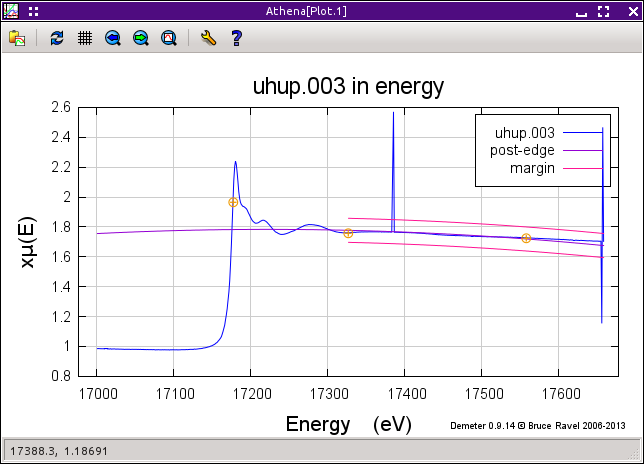3.3. Deglitching data¶
Todo
Make a figure that shows the result of the actual code snippet.
“Deglitching” is the process of removing spurious points from data. This is a slightly scary, slightly arbitrary procedure. There is, after all, no obvious definition of what consititutes a spurious point. If, however, you have reason to want to remove data points, this is how it's done.
DEMETER's deglitching procedure is very simple. Given one or more energy values, the data point closest in energy to each supplied value will be removed from the data. Deglitching, therefore, changes the representation of the data within both DEMETER and IFEFFIT.
In this example, some data are imported at lines 4-10 and plotted at line 12. At line 14, two points are removed from the data. Note that this method operates on the object itself. It does not return a new object. Finally at line 15 the deglitched data are plotted over the original data.
Multiple arguments can be given to the deglitch method. Each
argument is interpeted as an energy value and the point closest is
removed from the data.
1 2 3 4 5 6 7 8 9 10 11 12 13 14 15 | #!/usr/bin/perl
use Demeter;
print "Reading and plotting uhup.003\n";
my $d0 = Demeter::Data -> new(file => "path/to/uhup.003",
name => 'HUP',
energy => '$1', # column 1 is energy
numerator => '$3', # column 3 is I0
denominator => '$4', # column 4 is It
ln => 1, # these are transmission data
);
$d0 -> plot('e');
$d0 -> name("HUP, deglitched");
$d0 -> deglitch(17385.686, 17655.5);
$d0 -> plot('e');
|

Fig. 3.3 Here are the data from the code example above with one of the four glitchy point removed. In the case of these data, the glitches are due to a signal problem at the beamline and obviously represent spurious points.
The deglitch method is not the easiest thing to
use. DEMETER has no built in way of identifying potential
spurious points. This method is the most bare-boned implementation
possible: “Here are some data points ... remove them!” This
method is intended to be the backend of some kind of interactive,
graphical deglitching tool, like the one in ATHENA.
DEMETER is copyright © 2009-2016 Bruce Ravel – This document is copyright © 2016 Bruce Ravel
This document is licensed under The Creative Commons Attribution-ShareAlike License.
If DEMETER and this document are useful to you, please consider supporting The Creative Commons.
